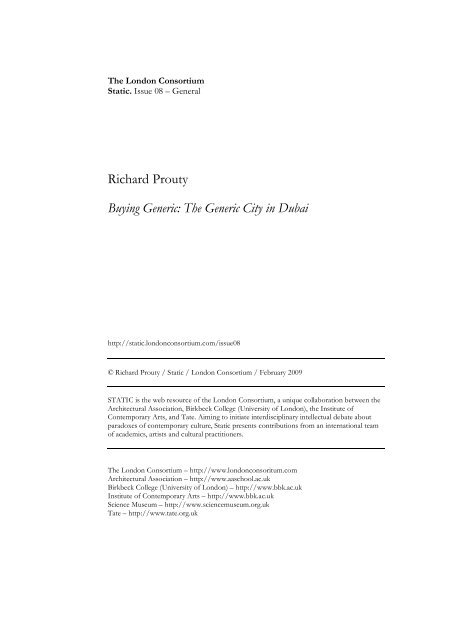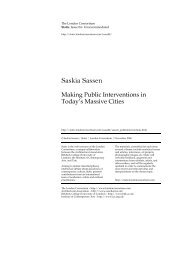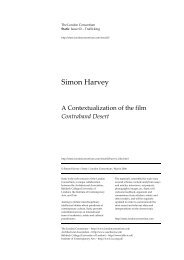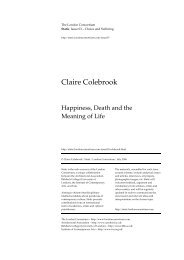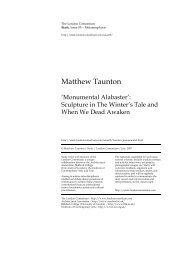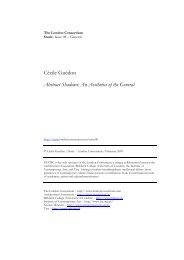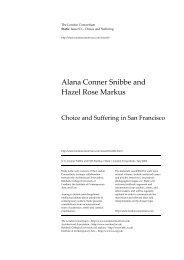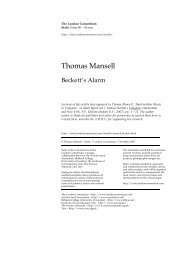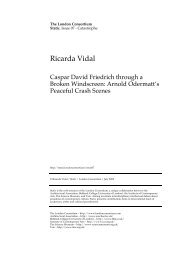Richard Prouty Buying Generic: The Generic City in Dubai
Richard Prouty Buying Generic: The Generic City in Dubai
Richard Prouty Buying Generic: The Generic City in Dubai
Create successful ePaper yourself
Turn your PDF publications into a flip-book with our unique Google optimized e-Paper software.
<strong>The</strong> London Consortium<br />
Static. Issue 08 – General<br />
<strong>Richard</strong> <strong>Prouty</strong><br />
<strong>Buy<strong>in</strong>g</strong> <strong>Generic</strong>: <strong>The</strong> <strong>Generic</strong> <strong>City</strong> <strong>in</strong> <strong>Dubai</strong><br />
http://static.londonconsortium.com/issue08<br />
© <strong>Richard</strong> <strong>Prouty</strong> / Static / London Consortium / February 2009<br />
STATIC is the web resource of the London Consortium, a unique collaboration between the<br />
Architectural Association, Birkbeck College (University of London), the Institute of<br />
Contemporary Arts, and Tate. Aim<strong>in</strong>g to <strong>in</strong>itiate <strong>in</strong>terdiscipl<strong>in</strong>ary <strong>in</strong>tellectual debate about<br />
paradoxes of contemporary culture, Static presents contributions from an <strong>in</strong>ternational team<br />
of academics, artists and cultural practitioners.<br />
<strong>The</strong> London Consortium – http://www.londonconsoritum.com<br />
Architectural Association – http://www.aaschool.ac.uk<br />
Birkbeck College (University of London) – http://www.bbk.ac.uk<br />
Institute of Contemporary Arts – http://www.bbk.ac.uk<br />
Science Museum – http://www.sciencemuseum.org.uk<br />
Tate – http://www.tate.org.uk
1 Static 08: General<br />
<strong>Richard</strong> <strong>Prouty</strong>, <strong>Buy<strong>in</strong>g</strong> <strong>Generic</strong><br />
In March 2008 Rem Koolhaas’s Office of Metropolitan Architecture<br />
(OMA) unveiled a plan for a m<strong>in</strong>i-city <strong>in</strong> <strong>Dubai</strong>—a dreamless city with<strong>in</strong> a<br />
dream city. Koolhaas is <strong>in</strong>ternationally famous for esoteric build<strong>in</strong>gs and<br />
pessimistic writ<strong>in</strong>gs on urbanism. His observations on the state of the<br />
contemporary city are summarized <strong>in</strong> his concept of the generic city,<br />
formulated most succ<strong>in</strong>ctly <strong>in</strong> an essay that concludes S,M,L,XL, his “novel<br />
about architecture” (Koolhaas and Mau 1995). Part description of actual<br />
urban phenomena, part thought experiment, Koolhaas’s “<strong>Generic</strong> <strong>City</strong>”<br />
announces the end of urbanism, the ideology that has shaped cities s<strong>in</strong>ce the<br />
seventeenth century. “<strong>The</strong> city is no longer,” he writes <strong>in</strong> the essay’s f<strong>in</strong>al<br />
l<strong>in</strong>es. “We can leave the theater now” (Koolhaas and Mau 1995: 1264). <strong>The</strong><br />
name of the <strong>Dubai</strong> project, Waterfront <strong>City</strong>, is a sly reference to one of the<br />
sections of the generic city, and the design has many of the hallmarks of the<br />
generic city. When complete,<br />
Waterfront <strong>City</strong> will occupy<br />
about 46 square kilometers<br />
on the western edge of<br />
<strong>Dubai</strong>. All of the culturallyspecific<br />
elements of<br />
Waterfront <strong>City</strong> will be<br />
crammed <strong>in</strong>to one district<br />
called Mad<strong>in</strong>at Al Soor, while<br />
the city’s four other districts<br />
will be known only by their<br />
functions: Resort, Mar<strong>in</strong>a,<br />
Boulevard, and Island. This<br />
last district is the centerpiece<br />
of the project: a perfectly<br />
square island made up of 25 identical blocks, upon which one and a half<br />
million people will live and work. <strong>The</strong> Island will be a Manhattan on the<br />
Persian Gulf, complete with a long rectangular park runn<strong>in</strong>g through its<br />
center, and on its tip, tak<strong>in</strong>g the place of the World Trade Center, a gigantic<br />
eye known simply as <strong>The</strong> Sphere.<br />
So what is the generic city, the last city, do<strong>in</strong>g <strong>in</strong> the center of <strong>Dubai</strong>, the<br />
city of the future? Dur<strong>in</strong>g its decade-long build<strong>in</strong>g frenzy <strong>Dubai</strong> has<br />
commissioned several showy displays of starchitect whimsy, so it's surpris<strong>in</strong>g<br />
to see the city embrace the deliberately bland rationalism of Koolhaas's<br />
generic city. At stake <strong>in</strong> the Waterfront <strong>City</strong> project is noth<strong>in</strong>g less than the<br />
possibility of creat<strong>in</strong>g, or recreat<strong>in</strong>g, a sense of uniqueness <strong>in</strong> urban space, of<br />
creat<strong>in</strong>g the impression that a particular city is like no other one <strong>in</strong> the world.<br />
What’s <strong>in</strong>terest<strong>in</strong>g, or ironic, about the Waterfront <strong>City</strong> project is that its<br />
developers have hired an architect who has proclaimed, emphatically, that<br />
such a th<strong>in</strong>g is no longer possible.<br />
<strong>Generic</strong> cities are everywhere, on every cont<strong>in</strong>ent, but they can be found<br />
most frequently <strong>in</strong> Asia. Like everyth<strong>in</strong>g else that is optimistic and corrosive,<br />
Koolhaas suspects that the concept orig<strong>in</strong>ated <strong>in</strong> the United States, but he<br />
can’t be sure (Koolhaas and Mau 1995: 1250). If the paradigmatic object of<br />
the n<strong>in</strong>eteenth-century city was the railroad station, the twenty-first century<br />
Waterfront <strong>City</strong>, <strong>Dubai</strong>. Image courtesy Office of Metropolitan<br />
Architecture
2 Static 08: General<br />
<strong>Richard</strong> <strong>Prouty</strong>, <strong>Buy<strong>in</strong>g</strong> <strong>Generic</strong><br />
generic city is modeled after the airport. Koolhaas asks, “Is the contemporary<br />
city like an airport—‘all the same’?” (Koolhaas and Mau 1995: 1248). Like<br />
airports, which are modern <strong>in</strong> exactly the same way, the generic city is a city<br />
without an identity—no past, no future, no dist<strong>in</strong>ction, no character. <strong>The</strong><br />
identities of most cities may be located <strong>in</strong> their centers, but paradoxically,<br />
<strong>in</strong>stead of be<strong>in</strong>g a fixed essence, the center of the city is often the subject of<br />
fretful debate about preserv<strong>in</strong>g and develop<strong>in</strong>g a city's identity. Meanwhile,<br />
outer neighborhoods muddle along, exist<strong>in</strong>g as noth<strong>in</strong>g but themselves, but<br />
also noth<strong>in</strong>g particularly essential.<br />
<strong>The</strong> generic city, by contrast, is noth<strong>in</strong>gness writ large. It has the desultory<br />
blandness of outer boroughs. But this very anonymity means the generic city<br />
doesn’t have to cl<strong>in</strong>g to an outmoded identity. <strong>The</strong> generic city is a city that’s<br />
been<br />
liberated from the captivity of center, from the straitjacket of<br />
identity. <strong>The</strong> generic city breaks with this destructive cycle of<br />
dependency: it is noth<strong>in</strong>g but a reflection of present need and<br />
present ability. It is the city without history. It is big enough<br />
for everybody. It is easy. It does not need ma<strong>in</strong>tenance. If it<br />
gets too small it just expands. If it gets old it just selfdestructs<br />
and renews. It is equally excit<strong>in</strong>g—or unexcit<strong>in</strong>g—<br />
everywhere. It is “superficial”—a Hollywood studio lot, it can<br />
produce a new identity every Monday morn<strong>in</strong>g. (Koolhaas and<br />
Mau 1995: 1249-1250)<br />
<strong>The</strong> generic city, Koolhaas declares, is “a city without qualities,” a condition<br />
that even vividly <strong>in</strong>dividualistic cities tend towards. Paris, for <strong>in</strong>stance, has<br />
turned itself <strong>in</strong>to a self-parody <strong>in</strong> an effort to rema<strong>in</strong> Parisian, while London<br />
changes constantly, only to become more and more like any other city<br />
(Koolhaas and Mau 1995: 1248). Eventually, Paris will turn <strong>in</strong>to Las Vegas,<br />
and London will become Atlanta (Koolhaas and Mau 1995: 836). 1<br />
Atlanta itself will be packed up <strong>in</strong>to skyscrapers, those stand-alone objects<br />
that kill off street life—the very essence of urban life. “<strong>The</strong> street is dead,”<br />
Koolhaas flatly declares (Koolhaas and Mau 1995: 1253). <strong>The</strong> lonely,<br />
beleaguered pedestrian of the generic city has come out the other end of a<br />
long historical process that began with Charles Baudelaire <strong>in</strong> mid-19th century<br />
Paris, a wounded romantic subject fight<strong>in</strong>g off the shock experience of the<br />
newly <strong>in</strong>dustrialized city. 2 In contrast to the lively spectacle of the n<strong>in</strong>eteenthcentury<br />
city, when material abundance was new enough to move Balzac to call<br />
Paris “the great poem of the display of goods,” sensations <strong>in</strong> the generic city<br />
are like Japanese food: they “can be reconstituted and <strong>in</strong>tensified <strong>in</strong> the m<strong>in</strong>d,<br />
or not—they may simply be ignored. (<strong>The</strong>re is a choice)” (Koolhaas and Mau<br />
1995: 1250). Among the historical detritus swept away by Koolhaas's generic<br />
1 Koolhaas observes that Atlanta grew so quickly that “the center/edge opposition is no<br />
longer the po<strong>in</strong>t. <strong>The</strong>re is no center, therefore no periphery. Atlanta is now a centerless city,<br />
or a city with a potentially <strong>in</strong>f<strong>in</strong>ite number of centers.” (Koolhaas and Mau, S,M,L,XL, 836)<br />
2 Walter Benjam<strong>in</strong> argues that the source of Baudelaire’s poetry is the confrontation with<br />
the “metropolitan masses.” Benjam<strong>in</strong> writes, “<strong>The</strong> mass was the agitated veil; through it<br />
Baudelaire saw Paris.” (Benjam<strong>in</strong>, 1968)
3 Static 08: General<br />
<strong>Richard</strong> <strong>Prouty</strong>, <strong>Buy<strong>in</strong>g</strong> <strong>Generic</strong><br />
city is urban experience itself. Public space is so general, so nonspecific, that<br />
there's noth<strong>in</strong>g to pay attention to except stoplights. <strong>The</strong> paradigmatic<br />
urbanite is no longer a latte-sipp<strong>in</strong>g hipster. Instead, it’s the weary sales rep<br />
who never completely unpacks his suitcase.<br />
<strong>The</strong> generic city is “unshapable.” It resists urban plann<strong>in</strong>g, beautification<br />
projects, and empowerment zones. No one will make a public television<br />
documentary about its history. No one gets nostalgic about it. It’s ruthlessly<br />
practical and eternally up-to-date. <strong>Generic</strong> cities simply “work—that is all”<br />
(Koolhaas and Mau 1995: 1255).<br />
This sort of pragmatic absolutism extends to the generic city's<br />
government as well. Koolhaas notes with forlorn vagueness that generic cities<br />
are apolitical, even a bit authoritarian (Koolhaas and Mau 1995: 1255). <strong>The</strong><br />
rule of law and the<br />
rationality of the<br />
democratic process are<br />
replaced by pure exchange.<br />
Everyone and everyth<strong>in</strong>g<br />
will be a commodity and<br />
suffer under the vagaries<br />
of the marketplace. In<br />
short, the generic city is<br />
the physical embodiment<br />
of the pr<strong>in</strong>ciple of<br />
exchange value <strong>in</strong> the<br />
Waterfront <strong>City</strong>, <strong>Dubai</strong>. Image courtesy Office of Metropolitan<br />
Architecture<br />
global economy.<br />
Which makes it<br />
perfect for <strong>Dubai</strong>. <strong>The</strong> city’s wealth comes from oil, a commodity that is at<br />
once from the earth and placeless. Its authorities are anonymous, benevolent<br />
pr<strong>in</strong>cel<strong>in</strong>gs try<strong>in</strong>g to build a new cultural capital of the Arab world. It's tell<strong>in</strong>g,<br />
however, that the forward-look<strong>in</strong>g Waterfront <strong>City</strong> is separated from any<br />
cultural or social reality of an actual Arab state by feudal moat. <strong>The</strong> city<br />
Koolhaas has designed resembles less a m<strong>in</strong>iature Manhattan--the Coney<br />
Island of Delirious New York—than an old Pentium Pro chip. <strong>The</strong>re's only one<br />
vestige of old humanism, and that's the macabre eye on a corner of the island.<br />
<strong>The</strong> dour functionalism of the Waterfront <strong>City</strong> has a collateral effect of<br />
tear<strong>in</strong>g the old human subject apart, atomiz<strong>in</strong>g it <strong>in</strong>to sensory apparatuses<br />
entirely dependent on the circuitry of the generic city to function.<br />
Not surpris<strong>in</strong>gly, the Office of Metropolitan Architecture never refers to<br />
Waterfront <strong>City</strong> as a generic city, but there are uncanny similarities<br />
everywhere. <strong>The</strong> Mad<strong>in</strong>at Al Soor district, the designated vernacular prec<strong>in</strong>ct,<br />
is “both a popular dest<strong>in</strong>ation and a unique place to live <strong>in</strong>. Designed to<br />
provide for a traditional Arabic sett<strong>in</strong>g, the masterplan attempts to revitalize<br />
the valuable qualities of historical settlements without forgett<strong>in</strong>g the<br />
immediate presence of one of <strong>Dubai</strong>’s most prestigious urban centres.”<br />
(Office of Metropolitan Architecture 2008). In “<strong>The</strong> <strong>Generic</strong> <strong>City</strong>” this<br />
district is known as “Lipservice, where a m<strong>in</strong>imum of the past is preserved.”<br />
<strong>The</strong> Lipservice section of the generic city, along with its companion<br />
districts—Afterthought, Waterfront, Too Late, 42 nd Street, and the Village—
4 Static 08: General<br />
<strong>Richard</strong> <strong>Prouty</strong>, <strong>Buy<strong>in</strong>g</strong> <strong>Generic</strong><br />
represent an “elaborate mythic operation” where history appears as a<br />
“service,” as just another commodity (Koolhaas and Mau 1995: 1256-1257).<br />
<strong>The</strong> similarities between the generic city and Waterfront <strong>City</strong>, however<br />
deliberate they may be on Koolhaas’s part, raise some questions. Is<br />
Waterfront <strong>City</strong> merely an experiment, funded by petrodollars, to see if a<br />
generic city can be constructed from scratch as a sort of Gesamtkunstwerk, a<br />
total work of art? Or does the project represent Koolhaas’s attempt to escape<br />
from the apparently <strong>in</strong>evitable drift toward sameness <strong>in</strong> a globalized culture?<br />
Nicolai Ouroussoff sees Koolhaas’s <strong>Dubai</strong> project as a provocative, if<br />
flawed experiment <strong>in</strong> a new k<strong>in</strong>d of urban space. He calls Waterfront <strong>City</strong> “a<br />
hybrid of the generic and the fantastic” that offers “a carefully considered<br />
critique not just of the generic city but of a potentially greater evil: the<br />
grow<strong>in</strong>g use of high-end architecture as a tool for self-promotion.”<br />
(Ouroussoff 2008). Ouroussoff has doubts about the design: some elements<br />
of the design are unimag<strong>in</strong>ative, the scale of the island development doesn’t<br />
seem quite right, and the exclusivity of the properties with<strong>in</strong> the Waterfront<br />
<strong>City</strong> would seem to preclude the social frisson that Koolhaas hopes the island<br />
will generate. Despite these shortcom<strong>in</strong>gs, Ouroussoff asserts that Koolhaas<br />
is directly confront<strong>in</strong>g the challenges of urbanism <strong>in</strong> the early twenty-first<br />
century.<br />
Mr. Koolhaas’s design proves once aga<strong>in</strong> that he is one of the<br />
few architects will<strong>in</strong>g to face the crisis of the contemporary<br />
city — from its grow<strong>in</strong>g superficiality to its deaden<strong>in</strong>g sterility<br />
— without fl<strong>in</strong>ch<strong>in</strong>g.<br />
If he fails he at least will have raised questions that most<br />
architects would prefer to leave safely unexplored. If he<br />
succeeds he could br<strong>in</strong>g us closer to a model of a city that is<br />
not only formally complex, but genu<strong>in</strong>ely open to the impure.<br />
(Ouroussoff 2008).<br />
It’s not entirely clear what k<strong>in</strong>d of impurity Koolhaas allows <strong>in</strong>to<br />
Waterfront <strong>City</strong>. Arguably, there’s no such th<strong>in</strong>g as a purely generic city, not<br />
even one that’s designed to be so from its <strong>in</strong>ception. Contemporary economic<br />
forces may scatter Kentucky Fried Chickens across the globe, but the same<br />
economic logic also allows for unexpected departures from the general and<br />
the fully expected. Say you f<strong>in</strong>d yourself <strong>in</strong> an unfamiliar North American city<br />
and you have a crav<strong>in</strong>g for Ch<strong>in</strong>ese or Indian food. Economist Tyler Cowen<br />
suggests you head right for the beat<strong>in</strong>g heart of the generic city: the strip mall.<br />
“It is common to see good ethnic restaurants grouped with mid-level or junky<br />
retail,” Cowen tells us (Cowen 2007: 152). Strip malls charge low rents, thus<br />
allow<strong>in</strong>g restaurant owners to experiment with new recipes and reta<strong>in</strong> less<br />
popular but more authentic dishes on the menu. A wide variety of good food<br />
is the only way a strip mall ethnic restaurant can attract sophisticated d<strong>in</strong>ers<br />
more <strong>in</strong>cl<strong>in</strong>ed to seek out urban ethnic enclaves, downtown nightspots, and<br />
high-end shopp<strong>in</strong>g malls—all of which are burdened with higher rents,<br />
mak<strong>in</strong>g them more concerned with table turnover than quality cuis<strong>in</strong>e.
5 Static 08: General<br />
<strong>Richard</strong> <strong>Prouty</strong>, <strong>Buy<strong>in</strong>g</strong> <strong>Generic</strong><br />
Of course, no one emigrates from Mumbai or Guangzhou just to feed the<br />
hungry people of Irv<strong>in</strong>g, Texas. Guangzhou (population 15,000,000, or the<br />
exact number of people who live <strong>in</strong> the typical generic city, accord<strong>in</strong>g to<br />
Koolhaas) and Mumbai (population 13,000,000) have urban problems more<br />
serious than too many Starbucks (Koolhaas and Mau 1995: 1252). <strong>The</strong><br />
problem of the teem<strong>in</strong>g, overcrowded city <strong>in</strong> a develop<strong>in</strong>g country is perhaps<br />
the most press<strong>in</strong>g challenge city planners and architects now face. <strong>The</strong><br />
urgency of the issue seems to have shaken Koolhaas out of the f<strong>in</strong> de siècle<br />
melancholy that <strong>in</strong>formed S,M,L,XL and his mus<strong>in</strong>gs on the generic city.<br />
He’s now <strong>in</strong>volved with the Harvard Project on the <strong>City</strong>, cheekily described <strong>in</strong><br />
Mutations as the project “formerly known as ‘<strong>The</strong> Project For What Used to<br />
be the <strong>City</strong>’” (Koolhaas, <strong>City</strong>, et al 2001: 19). Where S,M,L,XL opens with a<br />
photo montage of OMA’s messy Rotterdam headquarters—evidence of the<br />
mighty labors <strong>in</strong>volved <strong>in</strong> preserv<strong>in</strong>g the hysterical particularity of architecture<br />
aga<strong>in</strong>st the deaden<strong>in</strong>g <strong>in</strong>fluence of the generic city—Mutations beg<strong>in</strong>s with a<br />
series of stark declarations of the immensity of the problems fac<strong>in</strong>g<br />
develop<strong>in</strong>g world cities. On one page we’re warned, “In 2025, the number of<br />
city-dwellers could reach 5 billion <strong>in</strong>dividuals (two-thirds of them <strong>in</strong> poor<br />
countries)” (Koolhaas, <strong>City</strong>, et al 2001: 2). Another po<strong>in</strong>ts out that Tokyo will<br />
soon be the only wealthy city among the world’s top ten most populous. But<br />
if the city now has new problems, the culprit is still the same: the United<br />
States. Mutations has page after page of panoramic shots of American generic<br />
cities, each of them ev<strong>in</strong>c<strong>in</strong>g some s<strong>in</strong>ister homogeneity. Sometimes the<br />
photographs are presented without comment, their mean<strong>in</strong>gs self-evident.<br />
Sometimes the photographs are accompanied by scold<strong>in</strong>g captions. For<br />
<strong>in</strong>stance, a photograph of a stadium <strong>in</strong> the foreground of some anonymous<br />
American skyl<strong>in</strong>e prompts the authors to denounce the revival of American<br />
downtowns, regarded domestically as a triumph of Jane Jacobs-style humanist<br />
urbanism, as “no more than an opportunistic police-developer collaboration”<br />
(Koolhaas, <strong>City</strong>, et al 2001: 543).<br />
Which br<strong>in</strong>gs us back to <strong>Dubai</strong>. Despite its immense wealth and small<br />
native population, the city isn’t immune to the problems of the urban<br />
hypermasses. <strong>The</strong> city’s build<strong>in</strong>g boom has created vast slums on its dusty<br />
marg<strong>in</strong>s where immigrant workers are crammed <strong>in</strong>to squatter’s camps with<br />
little or no sanitation (Held, Cumm<strong>in</strong>gs and Held 2005: 131). <strong>The</strong>re have been<br />
periodic worker riots, to which the UAE government has responded by<br />
tighten<strong>in</strong>g police control over the slums and the developers who employ—<br />
and often exploit—immigrant workers (Oxford Bus<strong>in</strong>ess Group 2007: 156).<br />
For all the aggressive postmodernism of <strong>Dubai</strong>’s architecture, the city rema<strong>in</strong>s<br />
structured along the l<strong>in</strong>es of a European city <strong>in</strong> the early capitalist age: a<br />
wealthy, cultured core surrounded by a fester<strong>in</strong>g mass of laborers. In the case<br />
of <strong>Dubai</strong>, built largely by South Asian construction workers, the labor<strong>in</strong>g<br />
classes are an undifferentiated foreign other.<br />
Waterfront <strong>City</strong> will only re<strong>in</strong>force this social and geographical structure.<br />
Ironically, the problem isn’t that it’s too generic, but that it’s not generic<br />
enough. Although it isn’t democratic <strong>in</strong> the traditional sense, the generic city<br />
functions smoothly because it’s self-governed by millions of contented<br />
nobodies. Its constantly morph<strong>in</strong>g sprawl resists the designs of control freak<br />
urban planners and literal-m<strong>in</strong>ded authoritarians alike. Waterfront <strong>City</strong>,
6 Static 08: General<br />
<strong>Richard</strong> <strong>Prouty</strong>, <strong>Buy<strong>in</strong>g</strong> <strong>Generic</strong><br />
however, will hardly be a beacon of democratic freedom <strong>in</strong>side a medieval<br />
pr<strong>in</strong>cipality. Internally, Waterfront <strong>City</strong>’s population will be limited by the<br />
dimensions of the perfectly square island: 1310 meters by 1310 meters.<br />
Externally, access from the ma<strong>in</strong>land can be easily severed, should the<br />
pr<strong>in</strong>cel<strong>in</strong>gs and their friends get nervous.<br />
It appears unlikely that Waterfront <strong>City</strong> will do much to address the<br />
problem of swell<strong>in</strong>g urban populations, a cause now dear to Koolhaas. Nor<br />
does it offer an immediately recognizable breakthrough <strong>in</strong> the struggle aga<strong>in</strong>st<br />
a generalized global culture. Does the ambiguous nature of Waterfront <strong>City</strong><br />
mean that Koolhaas is just another architect will<strong>in</strong>g to do the bidd<strong>in</strong>g of an<br />
authoritarian government <strong>in</strong> order to land a lucrative commission? (Or she—<br />
the Iraqi-born Zaha Hadid, along with Frank Gehry, Jean Nouvel, and Tadao<br />
Ando have been criticized for work<strong>in</strong>g with the undemocratic UAE<br />
government; Jacques Herzog and Pierre de Meuron have faced similar<br />
criticism for design<strong>in</strong>g an Olympic stadium for Ch<strong>in</strong>ese communists.) Is<br />
Koolhaas just another cynical starchitect?<br />
Maybe. Or maybe Koolhaas has succumbed to an <strong>in</strong>st<strong>in</strong>ct even more<br />
primal than the lust for money. Koolhaas has described modern architecture<br />
as an otherworldly profession with apocalyptic dreams. In Delirious New York<br />
Koolhaas writes half-sympathetically, half-mock<strong>in</strong>gly of Le Corbusier’s<br />
grandiloquent plans for Manhattan. Koolhaas calls Le Corbusier’s stubborn<br />
<strong>in</strong>sistence on level<strong>in</strong>g Manhattan and turn<strong>in</strong>g it <strong>in</strong>to a Cartesian paradise a<br />
“Paranoid-Critical” impulse. However, Koolhaas knows this impulse <strong>in</strong>fects<br />
all architects, <strong>in</strong>clud<strong>in</strong>g the designer of the Waterfront <strong>City</strong>.<br />
Modern architecture is <strong>in</strong>variably presented as a last m<strong>in</strong>ute<br />
opportunity for redemption, an urgent <strong>in</strong>vitation to share the<br />
paranoiac thesis that a calamity will wipe out that unwise part<br />
of mank<strong>in</strong>d that cl<strong>in</strong>gs to old forms of habitation and urban<br />
coexistence.<br />
“While everybody else foolishly pretends that noth<strong>in</strong>g is<br />
wrong, we construct our Arks so that mank<strong>in</strong>d can survive the<br />
com<strong>in</strong>g flood . . .” (ellipses <strong>in</strong> orig<strong>in</strong>al). (Koolhaas 1994: 246).<br />
<strong>The</strong> Waterfront <strong>City</strong> keeps an unbl<strong>in</strong>k<strong>in</strong>g and wary eye on the Persian Gulf as<br />
it guards the <strong>in</strong>land sea of oil. But the former rises as the latter depletes. In<br />
this way Waterfront <strong>City</strong> stands poised between two potential catastrophes.<br />
Waterfront <strong>City</strong>, which grew out of the generic city and <strong>in</strong> many ways<br />
supersedes it, is an urbanism for an edgy time. <strong>The</strong> generic city is no longer a<br />
clever thought experiment, a symptom of American cultural dom<strong>in</strong>ance. In<br />
the twenty-first century the generic city has become the third world problem<br />
city by threaten<strong>in</strong>g to overwhelm the planet’s f<strong>in</strong>ite resources. <strong>The</strong> citizens of<br />
the generic city are no longer so copacetic.<br />
<strong>The</strong> design of the Waterfront <strong>City</strong> is an act of violence and<br />
accommodation. Koolhaas has ruthlessly circumscribed the generic city <strong>in</strong>to a<br />
square patch of landfill and starved it of the means to proliferate <strong>in</strong>def<strong>in</strong>itely,<br />
as it is wont to do. He’s also permitted the outdated ideology of urbanism to
7 Static 08: General<br />
<strong>Richard</strong> <strong>Prouty</strong>, <strong>Buy<strong>in</strong>g</strong> <strong>Generic</strong><br />
return: Walk<strong>in</strong>g has reclaimed its <strong>in</strong>tegrity; the creative energies fostered by<br />
density have been allowed to flourish aga<strong>in</strong>.<br />
F<strong>in</strong>ally, Waterfront <strong>City</strong> rem<strong>in</strong>ds us that the generic city describes a way of<br />
see<strong>in</strong>g as much as it describes a set of objects. Anyone who flies regularly has<br />
experienced the mild despair one feels when rid<strong>in</strong>g <strong>in</strong> a taxi through a<br />
sprawl<strong>in</strong>g nowhere. But live <strong>in</strong> one place long enough and subtle but dist<strong>in</strong>ct<br />
differences start to emerge. On that block over there the houses are just a<br />
little bit nicer than on this block; the differences between shopp<strong>in</strong>g malls can<br />
be sufficient to drive an extra five or six miles. No one really lives <strong>in</strong> a true<br />
generic city, which may be why Koolhaas is so reluctant to provide specific<br />
examples of them. A generic city is the humid boomtown you visit on<br />
bus<strong>in</strong>ess. It’s a transient space that can’t be fully <strong>in</strong>habited.<br />
<strong>Generic</strong>ization can be seen as either a bad side effect of <strong>in</strong>dustrialization,<br />
or what everyone wanted all along. Migrants to the great n<strong>in</strong>eteenth-century<br />
factory towns were attracted by the sheer abundance of goods available <strong>in</strong><br />
urban stores. Mass produced goods meant one was no longer dependent on<br />
the natural cycle of feast or fam<strong>in</strong>e. Besides, a quick glance down a rowhouse<br />
lane <strong>in</strong> a mill town <strong>in</strong> New England or the north of England reveals that<br />
standardized architecture isn’t a twentieth-century <strong>in</strong>vention. <strong>The</strong><br />
construction of the great Parisian boulevards by Baron Haussmann probably<br />
would have qualified as generic when they were first built: the city’s warren of<br />
narrow medieval lanes was cleared out and replaced by block after block of<br />
nearly identical apartment houses. Now Haussmann’s boulevards strike us as<br />
the very essence of the Parisian.<br />
Waterfront <strong>City</strong> is Haussmannization for the twenty-first century. Just as<br />
Haussmann’s boulevards and parks became a place for the urban bourgeoisie<br />
to display itself, Waterfront <strong>City</strong> will be a stage on which the urban will be<br />
played out <strong>in</strong> the 100-degree heat. Koolhaas’s crude architectural models are a<br />
k<strong>in</strong>d of m<strong>in</strong>imalist theater set upon which residents will project their own<br />
mean<strong>in</strong>gs. <strong>The</strong> generic quality of Waterfront <strong>City</strong> means that it won’t be<br />
burdened with the ersatz cultural identities the builders of <strong>Dubai</strong> are try<strong>in</strong>g to<br />
impose on other, more spectacular projects. <strong>The</strong> theater is still open after all.<br />
<strong>The</strong> only question rema<strong>in</strong><strong>in</strong>g is if the construction workers on the edges of<br />
<strong>Dubai</strong> will be allowed to participate.<br />
Works Cited:<br />
Benjam<strong>in</strong>, Walter (1968). ‘On Some Motifs <strong>in</strong> Baudelaire.’ In Illum<strong>in</strong>ations: Essays and<br />
Reflection, edited by Hannah Arendt, translated by Harry Zohn, 155-194. New York: Harcourt,<br />
Brace.<br />
Cowen, Tyler (2007). Discover Your Inner Economist: Use Incentives to Fall <strong>in</strong> Love, Survive Your<br />
Next Meet<strong>in</strong>g, and Motivate Your Dentist. New York: Dutton.<br />
Held, Colbert C., John Cumm<strong>in</strong>gs, and Mildred McDonald Held (2005). Middle East<br />
Patterns: Places, Peoples, and Politics. New York: Westview Press.<br />
Koolhaas, Rem (1994). Delirious New York. New York: Monacelli Press.<br />
Koolhaas, Rem, and Bruce Mau (1995). S,M,L,XL. New York: Monacelli Press.<br />
Koolhaas, Rem, Harvard Project on the <strong>City</strong>, Stefano Boeri, and et al (2001). Mutations.<br />
Edited by Hans-Ulrich Obrist. Bordeaux and Barcelona: Arc en reve centre d'architecture and<br />
ACTAR.
8 Static 08: General<br />
<strong>Richard</strong> <strong>Prouty</strong>, <strong>Buy<strong>in</strong>g</strong> <strong>Generic</strong><br />
Office of Metropolitan Architecture (2008). Waterfront <strong>City</strong>, UAE, <strong>Dubai</strong>, 2008.<br />
. Accessed May 30, 2008.<br />
Ouroussoff, Nicolai (2008). ‘<strong>City</strong> on the Gulf: Koolhaas Lays Out a Grand Urban<br />
Experiment <strong>in</strong> <strong>Dubai</strong>’, New York Times, March 3, 2008.<br />
Accessed May 26, 2008.<br />
Oxford Bus<strong>in</strong>ess Group (2007). <strong>The</strong> Report <strong>Dubai</strong> 2007. Oxford: Oxford Bus<strong>in</strong>ess Group.


